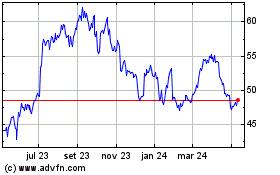UPDATE: Links Between BP, Contractors Likely To Endure Gulf Spill Fight
22 Abril 2011 - 7:28PM
Dow Jones News
The different companies implicated in the BP PLC (BP, BP.LN) oil
spill have finally unsheathed their swords in an all-against-all
legal battle over who gets blamed for the disaster. But outside the
courtroom, BP and the oil-field-service companies that it hired to
drill the ill-fated Gulf of Mexico well that blew out last year are
entangled in multiple endeavors across the globe, a situation
that's likely to outlast the bitter litigation.
BP on Wednesday sued drilling contractor Transocean Ltd. (RIG,
RIGN.VX), cement provider Halliburton Co. (HAL) and Cameron
International Corp. (CAM), the maker of the blowout preventer that
failed to contain the gusher of oil and gas that came out of the
gulf's depths on April 20, 2010. The defendants responded in kind,
suing BP and their fellow contractors in turn.
The lawsuits are widely seen as a legal maneuver, filed under a
deadline that coincided with the anniversary of the Deepwater
Horizon explosion. But the allegations--ranging from negligence to
faulty planning, maintenance and design--are serious, and the
stakes are in the billions of dollars.
The companies, however, are conscious that they're likely to
keep working together for a long time and that they must limit
their animosities to the Deepwater Horizon case, said David Logan,
dean of the Roger Williams University School of Law.
"These are big boys and girls; they're used to playing rough,"
Logan said. "They'll keep playing in the game."
The dual dynamic of confrontation and collaboration surrounding
the Deepwater Horizon incident underscores the tightly knit nature
of the oil industry, where energy producers--the companies that
make money by extracting oil and gas and selling it--have long-term
relationships with a plethora of service providers that specialize
in complex technologies.
The massive responsibility of the BP spill was quick to create
tension in the oil industry, however: Transocean, BP and
Halliburton were quick to blame each other amid the governmental
and media grilling that followed the incident. BP's peers, such as
Exxon Mobil Corp. (XOM) and Chevron Corp. (CVX), were also quick to
distance themselves from the U.K. oil company, with which they have
often participated in joint ventures.
Transocean's annual report acknowledges that its relationship
with BP, its biggest client, accounting for 10% of its 2010
operating revenue, could "be negatively impacted" by the Deepwater
Horizon incident. "The loss of this customer or another significant
customer could, at least in the short term, have a material adverse
effect on our results of operations."
But for now, the companies are locked into years-long drilling
contracts valued at more than $3.2 billion.
Halliburton, in a securities filing Friday, also warned
investors that "our relationships with BP and others involved in
the Macondo well incident could be negatively affected."
In many disputes, the threat of the customer walking away gives
the buyer leverage in negotiating a settlement. But if there's no
other seller, then the tables might turn, said Michael Marino, an
analyst with Stephens Inc., a Little Rock, Ark., investment
bank.
Transocean is the world's largest deepwater-drilling contractor.
Cameron built 43% of the blowout preventers that have been
installed offshore. Halliburton is the world's second-largest
oil-field-services company after Schlumberger Ltd. (SLB). They are
all players in a market that's straining to keep up with demand
from producers ramping up output as high oil prices continue.
While Cameron may see some of its market share shrink as it
deals with recent findings by a government-commissioned study about
faults in blowout preventer design, BP is likely to see that "there
aren't many alternatives to Transocean and Halliburton," said Bill
Herbert, an analyst with Simmons & Co.
If, say, BP were to fire Halliburton, there's no telling how
long it would take to replace its employees and equipment
throughout the U.K. oil company's far-flung empire. Familiarity may
also give BP managers pause in parting with contractors. "These
guys have 30-year relationships in the oil patch," Marino said.
Marino said that even the handling of the Deepwater Horizon
incident showed how linked these companies were. Despite the fact
that they were already finger-pointing, BP used Transocean rigs to
drill the relief well that killed the runaway gusher and hired
Halliburton to cement the well shut.
-By Angel Gonzalez and Ryan Dezember, Dow Jones Newswires;
713-547-9214; angel.gonzalez@dowjones.com
Schlumberger (NYSE:SLB)
Gráfico Histórico do Ativo
De Jun 2024 até Jul 2024

Schlumberger (NYSE:SLB)
Gráfico Histórico do Ativo
De Jul 2023 até Jul 2024
